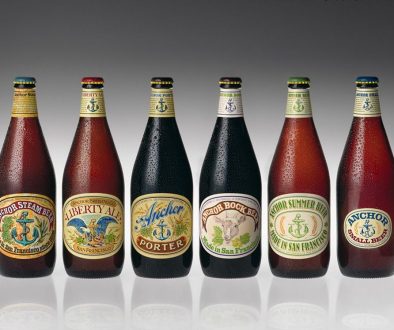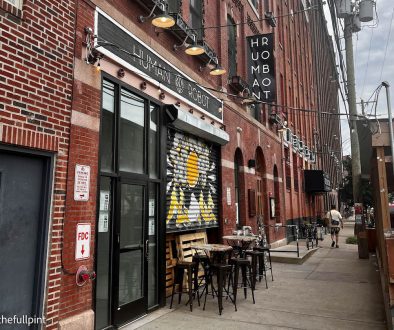The High End Continues to Take The Low Road
Nothing is more annoying than beating a dead horse. Whether it be a joke, a meme, a song, or a tale, it gets annoying for the person spewing it as well as the person having to listen to it. But here we are at the end of June 2017 having to report on AB-InBev making fools out of themselves and showing that despite having all of the money in the world, they are tone deaf when it comes to public relations.

Last summer, The High End, the portfolio former craft breweries Anheuser Busch purchased in the U.S., trotted out Meg Gill of Golden Road and a few other figureheads on a press tour asking why can’t we all be one happy family of brewers. The main narrative has been that even though they are part of the mega-corporation, that they are still craft brewers, still making great beer and that it is business as usual. While there are varying degrees of response to that narrative within the craft beer industry, my stance is that they should stop looking for street cred and just make their beer.
READ: Good Ideas Executed Poorly: The Brewers Association Chases Independence

It seems like lack of love and acceptance is eating a hole in the hearts of the likes of Wicked Weed, Elysian, 10 Barrel and others, as they are continuing to grovel whenever they have a chance. Earlier this week, the trade organization that represents the 5,000+ craft breweries, the Brewers Association, launched a campaign to help these small brewers differentiate themselves from the large corporate beers that are trying to blend in with independently owned craft beers. While there was varying degrees of support for this initiative, the top-level message was largely accepted amongst the independent craft beer community.
READ: The AB-InBev “Why Don’t They Like Us” Tour Continues
Instead of leaving the little guys be, AB-InBev quickly went on the defense (with a sprinkle of offense) with an eye rolling op-ed in the Chicago Tribune, in which the president of The High End portfolio proclaimed “we’re all just making good beer”, dismissing points about the unfair business practices that have craft breweries up in arms. They even went a step further by promoting this piece on their social media channels with a sponsored post boost. Not only was this eye rolling for the message at hand, it was also pretty interesting they were able to inject themselves into mainstream press in order to combat the Brewers Association’s grassroots campaign.
As if that wasn’t sad enough, they then released a slick video in which six High End brewers attempted to chop down the Independent Craft campaign, completely missing the mark as to why this campaign was even launched. I don’t blame these brewers; they are merely doing what they are told by their overlords. It’s pathetic, but I get it. Instead of AB-InBev just being content with owning the majority of the world’s beer and being content they actually have some higher quality beer being made compared to what they had five years ago, they are acting like a desperate dumped girlfriend attempting to patch things up. They don’t want a piece of the pie, they don’t want half the pie, they don’t want most of the pie: they want the whole fucking pie. After watching that video, you will notice that they have added a new twist to their plea. “It’s us versus wine and spirits.” Look for that to be included in future pathetic memes and campaigns. Anyone who didn’t care for the Brewers Association’s campaign should look at these lame attempts of blurring the lines to better understand why something needed to be done. Every chance AB-InBev has to just act content, brew their beer, and make their gobs of money, but instead choose to take the low road with public relations failures.




July 26, 2017 @ 9:10 pm
Craft Beer isn’t losing to wine and spirits, it’s losing to Budweiser…
10 Barrel San Diego Attempting Pathetic Publicity Stunt • thefullpint.com
July 17, 2017 @ 1:18 pm
[…] In response to The Brewers Association attempting to differentiate themselves from AB-InBev’s faux craft, The High End produces a slick video saying the real battle is against wine and spirits. The High End Takes the Low Road […]
Episode #118: Longship Brewery’s 1st Anniversary | San Diego BeerTalk Radio - A San Diego craft beer podcast
July 3, 2017 @ 4:00 am
[…] “Six viewpoints” video and op-ed in Chicago Tribune […]
July 2, 2017 @ 8:38 pm
What is AB InBev’s Long Term Goal?
Anheuser-Busch InBev, the multinational behemoth with 70 percent of the American beer market (after its buyout of SABMiller) and over a third of the world’s beer production (sales were over $14 billon in just the last quarter), has acquired nearly a dozen respected “craft” breweries and the nation’s largest homebrew supply operation. What’s the strategy?
AB InBev’s roots go back to the 1980s, when three Brazilian entrepreneurs bought Brahma, a struggling regional brewer. They merged with family-owned Belgian powerhouse Interbrew in 2004 to create InBev. That company launched a hostile takeover of America’s largest brewer, Anheuser-Busch, in 2008 for $52 billion. “Over my dead body,” said the apparently deceased August Busch IV. The company then acquired rival SABMiller for a head-spinning $103 billion.
Domestically, A-B has been losing market share for its core products for the last 15 years. The number of “craft” breweries in the U.S. just topped 5,300 — an astounding number, considering the growth in the same 15-year period. Naturally, A-B would like a part of this lucrative and growing segment of the beer business. It now owns 10 prestigious (formerly “craft”) breweries: Goose Island Beer, Blue Point Brewing, 10 Barrel Brewing, Elysian, Golden Road, Four Peaks, Breckenridge Brewery, Devils Backbone, Karbach Brewing and newly acquired Wicked Weed.
Profits from these recently acquired breweries won’t offset the loss in revenue with declining lager sales, but it helps. Mainly, A-B can now offer a diverse array of “crafty” brands for its beleaguered distributor network, which is reluctant to bring in craft brands not approved or owned by A-B. This also allows for the appearance of variety at multitap retailers while A-B still “owns” the entire tap lineup. AB InBev recently introduced an incentive to its distributors in which the company would refund 75 percent of a distributor’s required marketing spent on AB InBev brands if AB InBev beers made up 98 percent of that distributor’s sales. That’s slightly short of August Busch III’s infamous “100 percent share of mind” demand in the pre-InBev days.
A trendy bar offering Goose Island, Elysian, Golden Road and now Wicked Weed taps along with the usual Bud, Bud Light and Stella Artois looks like amazing variety, but all these beers now come from company-owned breweries. And many of the top-selling beers, like Goose Island 312 and IPA and Elysian Space Dust IPA, are being made at several of A-B’s 12 production breweries around the country. Ricardo Melo, the company’s vice president of sales strategy, told The Wall Street Journal the plan will improve AB InBev’s offerings for consumers and better equip wholesalers to compete. A consequence of this is the greatly reduced opportunity for non–A-B craft breweries to gain access to market through the A-B distribution network.
Another consequence of this crafty consolidation is enforcement of liquor control rules regarding a brewery cutting deals with a retailer to offer only its own beers. Daniel Person, writing in the Seattle Weekly, detailed a recent law enforcement action at a local heavy metal bar called the Showbox. The bar had a tap lineup that included Goose Island from Chicago, 10 Barrel from Bend, Elysian from down the street and, for the less adventurous, Bud and Bud Light. Undercover officers for the Washington State Liquor and Cannabis Board were looking into allegations from a small brewer that accused A-B of cutting a deal with the music venue to gain exclusive access to its bar, thus cutting off small competitors from a lucrative market. While a bar serving only one brewery’s products is not in itself illegal, the state is charging that A-B, working through a third-party distributor, entered into sponsorship contracts at three Seattle venues to achieve a monopoly position, which does run afoul of regulations. Based on its findings, the state has fined A-B $150,000.
Massachusetts regulators recently accused A-B of giving away nearly $1 million worth of beer equipment to hundreds of bars and package stores as part of an illegal inducement campaign to push sales of Budweiser and its other products while stifling those of competitors. The charges lend credence to complaints by small breweries that anticompetitive tactics are pervasive in the beer industry as large brewers and their distributors try to stop the bleeding of sales to the growing craft beer movement. A-B faces a hearing over the alleged scheme that could result in the suspension or revocation of the company’s liquor license. Serious stuff.
If A-B was slow to grasp the significance of the American craft beer revolution, it is driving the narrative internationally. And there is no bigger potential market for craft beer than in China, with its $80 billion beer thirst, the biggest in the world, expanding exponentially. AB Inbev, along with Heineken (which just bought the other half of Lagunitas) and Constellation Brands (with its brand powerhouse Ballast Point), is poised for vast expansion worldwide.
And the rules of engagement offshore are vastly different from those in the United States. Scott Cendrowski, writing in Fortune magazine, pointed out that China’s weak regulatory climate allows a well-funded player like AB InBev to muscle into the market in ways that wouldn’t pass muster in the U.S. His research points to situations where A-B leaned on distributors to keep them from carrying other craft beers. “It has given bars incentives to promote Goose ¬Island while shoving other beers off the taps — deals that would be illegal in the States. It’s offering lavish salaries to poach local brewing talent,” said Cendrowski.
The article suggests that, since early 2016, the Belgian-Brazilian beer conglomerate has inundated Beijing and Shanghai with Goose Island, the Chicago-based brand it acquired in 2011. Goose Island brews exotic beers and has the kind of cute animal logo that can turn heads, and tastes, in China. “The campaign is central to AB InBev’s strategy of promoting pricier beer to China’s growing ranks of wealthier young hipster consumers. While competitors (including Heineken and Duvel) are importing their own craft beers, none have moved with the same gusto [as A-B],” wrote Cendrowski.
Chris Herron, an industry veteran with many years in management at Miller and Diageo, wrote a brilliant piece called “Watch the Hands, Not the Cards — The Magic of Megabrew.” He suggests that paying attention to business fundamentals will reveal a lot more about a big brewer’s concerns in today’s corporate climate. How many small brewers are concerned with factors like brand equity, goodwill and impairment charges?
AB InBev’s 2016 balance sheet, according to Herron, shows that its “goodwill” represents nearly 53 percent of its assets, approximately $136.5 billion (yes, billion). That brand value ties to consumer perception, which is why AB InBev cares so much about how you perceive its brands.
“While everyone thinks that AB InBev is truly interested in getting into craft and building these brands (which is a secondary goal at best), I submit that maybe buying craft breweries is more of a tool to devalue the craft category and increase the brand equity of their core legacy beers,” said Herron. “The impairment charges AB InBev could face are worth billions more than any craft brand they have purchased, and those purchases would be a small price to pay to save a legacy brand. These craft brands, whether they realize it or not, may just be pawns in the AB InBev game of chess. AB InBev is not a collaborator; they are a competitor, and a damn smart one. If one of these craft brands they buy is a successful long-term brand, great, but more important to AB InBev is the vital role they play in the short-term of ensuring that their premium brands retain long-term value.”
So, while we beer geeks discuss the fine points of Citra versus Mosaic, Big Beer is plotting our beer future …
February 13, 2018 @ 4:31 am
tl;dr, but When you type ” 70 percent of the American beer market (after its buyout of SABMiller)”, are you that unaware of the US Beer business, or are you just being intentionally misleading? Because it seems to me that someone who writes 1300 words on the state of the US Beer Business and ABI’s intentions within it surely must know that AB does not have any control of the supply, route to market, marketing or sales of the Miller/Coors portion of the US Beer Biz, and that the Coors piece (which you used to get to your 70% magic #) was obviously never in play during the SABMiller buyout. So which is it? Ignorant or a liar?
July 2, 2017 @ 10:51 am
The craft brewing community has a long uphill battle if they think ABInbev is going to roll over and allow the small independent brewer to make gains without them. With their immense power and money, its not wonder why so many regional and local brands have sold their companies to them. Some people call it selling out, while I call it the american dream.
December 26, 2017 @ 9:25 am
Everyone has the right to sell out that’s not the dispute. It’s no wonder when $B’s are thrown around that a brewery owner will sell out. What’s not cool is predatory sales practices, monopolist activities, hop and barley hoarding and right out lying about these practices that have nothing to do with the “American Dream”.
July 2, 2017 @ 9:51 am
I guess the best way to take crap is to fling it back. It’s disheartening to see the ignorance of both side and see the walls Brewer’s build between each other.
June 30, 2017 @ 8:26 pm
Interesting no mention of Blue Moon….